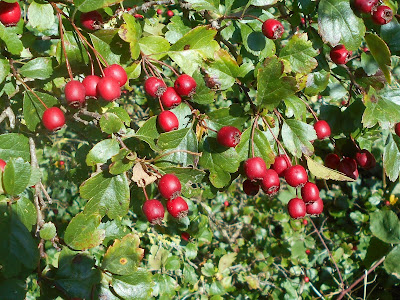 |
Midland Hawthorn was in fruit in Stefen Hill Pocket Park.
19 September, 2019
|
All other hawthorns in the immediate area are of Common Hawthorn, C. monogyna, so it seems quite likely that the seeds will produce a number of hybrids.
Also bearing fruit were brambles, Rubus fruticosus. In this case the principal foraging animal seems to be Homo sapiens, but wasps were not far behind, especially where the fruit was over-ripe.
 |
| The brambles are heavy with fruit. 19 September, 2019 |
As I have mentioned before, there are many forms of R. fruticosus and the study of these micro-species is known as batology. The word is derived from the Ancient Greek baton, a blackberry. This is something all people need to know!
Rose hips were in evidence but their hips were not being consumed. However the leaves were providing food for several creatures such as the Rose Sawfly, Arge ochropus. Gardeners squeal with delight when they find the larvae on their cherished ramblers, stripping the leaves down to the midrib (and often consuming that too). I found it on our 'Golden Showers' last year and was less than impressed.
 |
| Rose Sawfly in Stefen Hill Pocket Park. 19 September, 2019 |
Another insect larva feeding on rose leaves - and less likely to induce apoplexy in the gardener - was the Grey Dagger Moth, Acronicta psi. It is a common moth but is not easy to distinguish from the Dark Dagger - at least, not as an imago. However, the caterpillar is a different matter, with that of the Grey Dagger being very distinctive.
 |
The Grey Dagger Moth has a striking larva. Here on rose in Stefen Hill
Pocket Park. 19 September, 2019
|
It has a broad and bold yellow stripe down the back and a spike of black hair just behind the head. The 'dagger' refers not to the spike of black hair but arrow-shaped markings on the adult wings.
Although in the pocket park it was feeding on rose it is equally happy on a range of other deciduous shrubs and trees, i.e. it is polyphagous. Such adaptable insects avoid the danger faced by monophagous insects such as the Bleached Pug, which feeds only on Golden-rod. Should that become unavailable...end of.
 |
Grey Dagger larva showing the carefully gelled spike of hair
a little behind the head.
|
Although in the pocket park it was feeding on rose it is equally happy on a range of other deciduous shrubs and trees, i.e. it is polyphagous. Such adaptable insects avoid the danger faced by monophagous insects such as the Bleached Pug, which feeds only on Golden-rod. Should that become unavailable...end of.
.
No comments:
Post a Comment